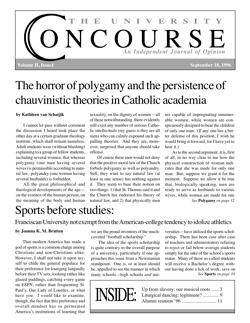Dance has no place in Liturgical context
by Amanda Glass
Among the events advertised for the recent opening of the school year conference here on campus was a liturgical dance, performed before Mass in the tent by a woman who holds a degree in “interpretive sacred dance.” That this was allowed to take place at all is hardly more fantastic than the fact that it was touted as one of the attractions of the weekend—especially considering that the weekend was supposed to set the tone for the whole semester. This is not a hyper-conservative or “traditional” reaction to a novel form of worship. Even if the performance does not occur during the actual Mass—i.e., between the Sign of the Cross which begins the Mass and that which ends it—liturgical dancing has no place in any type of formal service, and it is most out of place in the context of the Mass. The truth of this can be demonstrated on two levels, both of which are related to the purpose of the Mass.
Speaking generally, it cannot be said that art has no place in the Mass; this was evident in past ages at least, in the architecture and decoration of churches. A great deal of the glory of the Baroque period, when the Church was recovering from the Protestant Revolt, was derived from the soaring design and splendid ornamentation in the churches of the time. The same can be said of music; it could never be asserted that Mozart’s Ave Verum, for example, is not art. However, it is equally indefensible to say that any art is permissible in the Mass.
To allude to an illustration used in the debate over sacred music, Beethoven’s Third Symphony, while undoubtedly a masterpiece, would not make a suitable Communion hymn; and it would be shocking to make a theatrical presentation out of the Eucharistic prayers. Yet music and drama are both legitimate forms of art. The difference between the Ave Verum and Beethoven’s Third is one of purpose. The former is art for God; it gives glory to God through art by concentrating attention on Him. This is not to say that Mozart kept this in mind when he composed it, or even that he thought of it at all. Regardless of his mental attitude, however, the piece is superbly suited to the Mass; the words of the prayer combined with the harmonies of voice and instrument lift the soul and seem to permit a murmur of the divine to reach us. In contrast, while Beethoven’s Third might conceivably inspire thoughts of God through the genius and sublimity of the composition, and could be said to reflect the divine by virtue of those attributes, nevertheless it is not art for God’s sake. Hence, it does not belong in the context of the Mass. Not only does it not specifically seek to focus on God, but it could, by the thoughts and emotions it produces, very easily distract one from the rituals and the moment for which they prepare. The purpose of music during the Mass is the same as the purpose of everything else concerned with the liturgy, whether architecture, stained glass, statuary, or formal prayers: it helps the congregation to concentrate on God. This is why Gregorian Chant, for instance, is regarded as supremely appropriate for the Mass: it aids prayer by inspiring thoughts proper to the Mass, and does not intrude or get in the way of the desired frame of mind.
I do not mean by these examples to equate liturgical dancing with Beethoven’s Third in any way except by analogy. Neither ought to be performed at Mass, because neither is art for God’s sake; neither is focused primarily on God. Dance is a legitimate form of art, but it is by its nature very restricted in its scope. Music can be either religious or secular and should be included in or omitted from the Mass accordingly; the same is true of the visual arts. But dance is intrinsically unsuited to formal liturgy. It is not art for God’s sake, even if that is the intention of the performer, because dance is meant to exhibit the grace and discipline of the human body. Dance can be a very good thing; Tchaikovsky’s Swan Lake is a lovely thing to see performed, yet its focus is the body. Therefore, liturgical dance not only has the negative effect of distracting from the attention due to the sacred mysteries and to God, but it demands notice of something which, in the circumstances, ought not to be in the spotlight at all. This is a positive intrusion into the Mass. The priest’s action in the lifting of the Host at the Consecration is meant to draw attention to the mystery taking place. The dancer’s action is meant primarily to draw attention to her movements. This is enough; once this is true of any action, then its liturgical value is lost, regardless of the motives with which it is performed.
No disrespect is meant to the art of dance. On the contrary, it ought be to kept separate from the liturgy, and enjoyed for its own sake. Its introduction into churches around the country has had the unfortunate consequence of cheapening it by placing it where it does not belong and where, intentionally or not, it distracts the congregation from the proper focus of the Mass.
To retain the dignity of dance as an art form, and even more to safeguard the dignity of the Mass, the two should not be combined.
Amanda Glass is a sophomore Humanities and Catholic Culture major.


